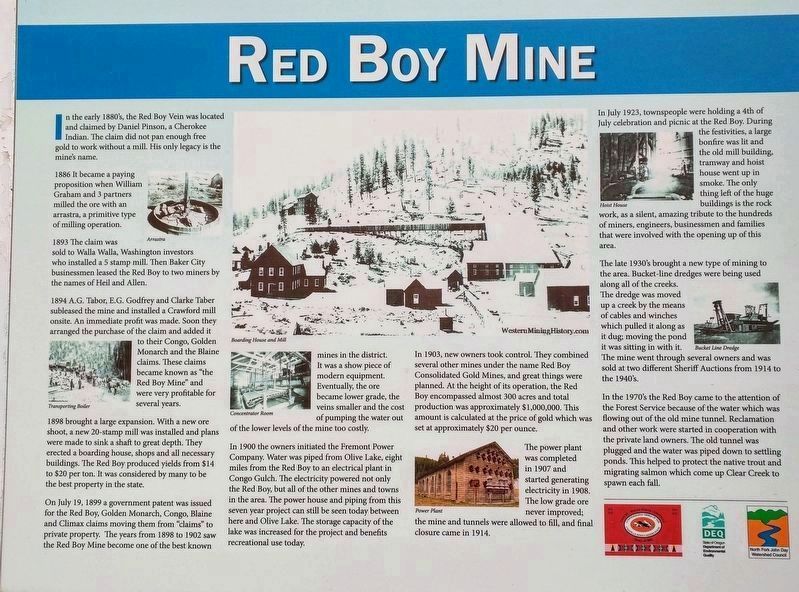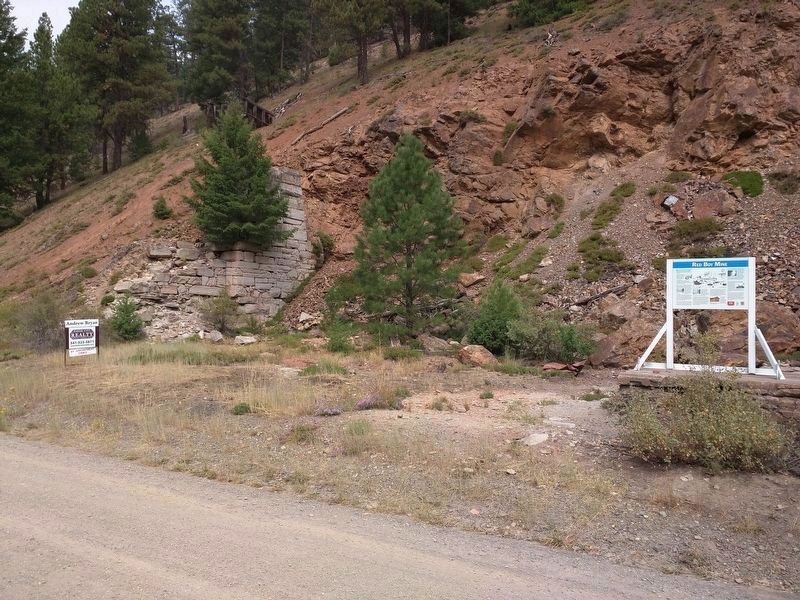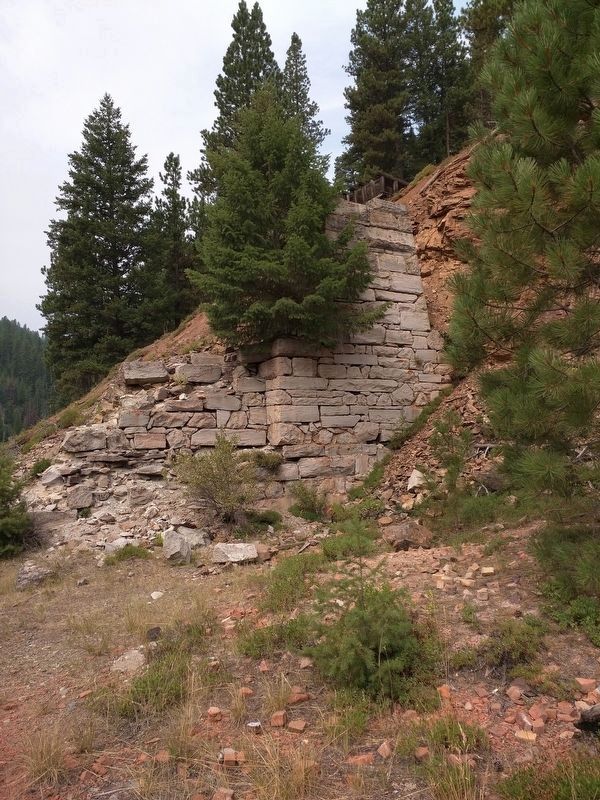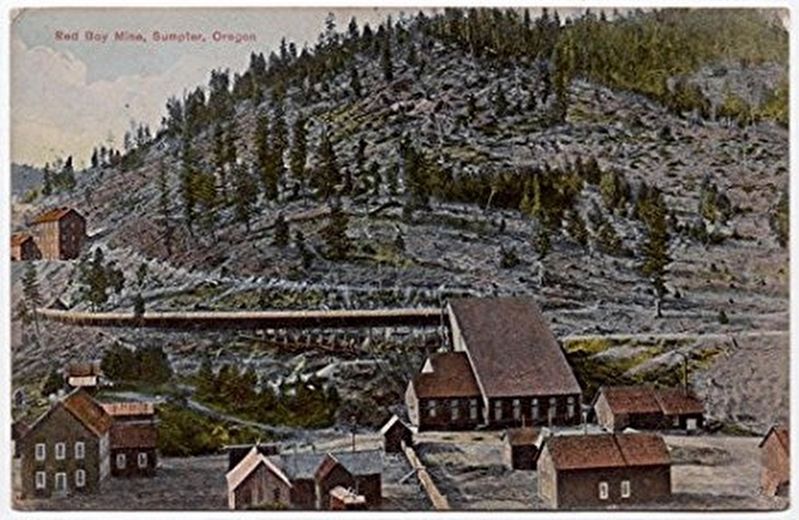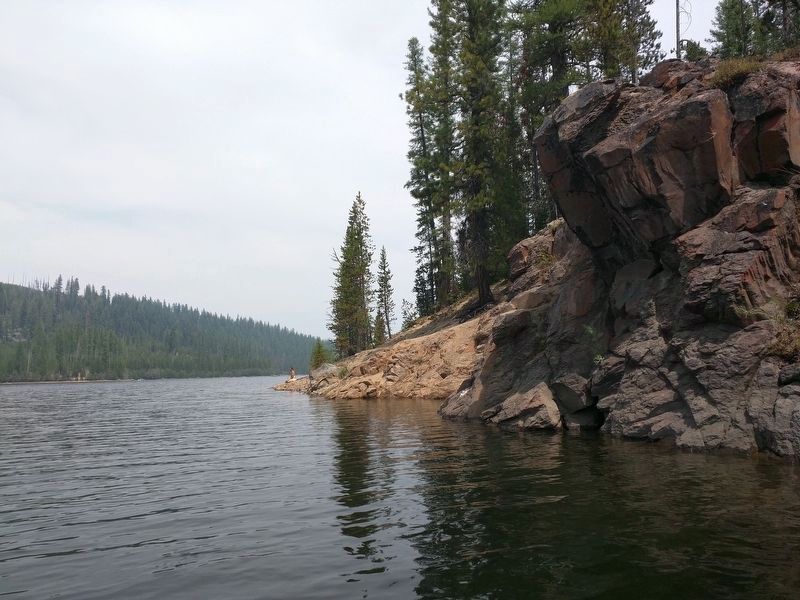Near Granite in Baker County, Oregon — The American West (Northwest)
Red Boy Mine
In 1886 it became a paying proposition when William Graham and three partners milled the ore with an arrastra, a primitive type of milling operation.
In 1883 the claim was sold to Walla Walla, Washington investors who installed a five stamp mill. Then Baker City businessmen leased the Red Boy to two miners by the names of Heil and Allen.
1894 A.G. Tabor, E. G. Godfry and Clarke Tabor subleased the mine and installed a Crawford mill onsite. Am immediate profit was made. Soon they arranged the purchase of the claim and added it to their Congo, Golden Monarch and Blaine claims. These claims became known as "the Red Boy Mine" and were profitable for several years.
1898 brought a large expansion. With a new ore shoot, and new 20 stamp mill was installed and plans were made to sink a shaft to great depth. They erected a boarding house, shops and all necessary buildings. The Red Boy produced yields from $14 to $20 per ton. It was considered by many to be the best property in the state.
On July 19, 1899 a government patent was issued for the Red Boy, Congo, Golden Monarch, Blaine and Climax claims moving them from "claims" to private property. The years from 1898 to 1902 saw the Red Boy Mine become one of the best known mines in the district. It was a show piece of modern equipment. Eventually, the ore became lower grade, the veins smaller, and the cost of pumping the water out of the lower levels of the mine too costly.
In 1900 the owners initiated the Fremont Power Company. Water was piped from Olive Lake, eight miles from the Red Boy to an electrical plant in Congo Gulch. The electricity powered not only the Red Boy, but all of the other mines and towns in the area. The powerhouse and piping from this seven year project can still be seen today between here and Olive Lake. The storage capacity of the lake was increased for the project and benefits recreational use today.
In 1903, new owners took control. They combined several other mines under the name Red Boy Consolidated Gold Mines, and great things were planned. At the height of its operation, the Red Boy encompassed almost 300 acres and total production was approximately $1,000,000. This amount is calculated at the price of gold which was set at approximately $20 per ounce.
The power plant was completed in 1907 and started generating electricity in 1908. The low grade ore never improved; the mine and tunnels were allowed to fill, and final closure came in 1914.
In
July 1923, townspeople were holding a 4th of July celebration and picnic at the Red Boy. During the festivities, a large bonfire was lit and the old mill building, tramway and hoist house went up in smoke. The only thing left of the huge buildings is the rock work, as a silent, amazing tribute to the hundreds of miners, engineers, businessmen and families that were involved with the opening up of this area.
The late 1930's brought a new type of mining to the area. Bucket-line dredges were being used along all of the creeks. The dredge was moved up a creek by the means of cables and winches which pulled it along as it dug; moving the pond it was sitting in along with it. The mine went through several owners and was sold at two different Sheriff's Auctions from 1914 to the 1940's.
In the 1970's the Red Boy came to the attention of the Forest Service because of the water which was flowing out of the old mine tunnel. Reclamation and other work were started in cooperation with the private land owners. The old tunnel was plugged and the water was piped down to settling ponds. This helped to protect the native trout and migrating salmon which come up Clear Creek to spawn each fall.
Erected by The Confederated Tribes of the Umatilla Indian Reservation, the Oregon Department of Environmental Quality, and the North Fork John Day Watershed Council.
Topics. This historical marker is listed in these topic lists: Industry & Commerce • Natural Resources. A significant historical year for this entry is 1886.
Location. 44° 47.683′ N, 118° 28.682′ W. Marker is near Granite, Oregon, in Baker County. Marker is on Forest Service Road 10 (County Road 24) 0.3 miles south of Federal Road 13, on the right when traveling west. Approximately five miles east of the town of Granite. Touch for map. Marker is in this post office area: Sumpter OR 97877, United States of America. Touch for directions.
Other nearby markers. At least 4 other markers are within 14 miles of this marker, measured as the crow flies. The Fremont Powerhouse Historic District (approx. one mile away); Granite, Oregon / Leaving Granite (approx. 2.9 miles away); Ah Hee Diggings (approx. 3.9 miles away); The Oxbow Conservation Area (approx. 14 miles away).
Additional commentary.
1. It's in the family
My 3rd great grandfather Albert Tabor's daughter Matilda "Mattie" married Oscar Benson, (a later partner of Albert). A family heirloom is an engraved on gold pocket watch given to Mattie from Oscar, made of gold from the mine.
— Submitted February 18, 2023, by Anthony Rogers of Lewiston, Idaho.
Credits. This page was last revised on March 4, 2023. It was originally submitted on August 9, 2017, by Don Hann of Canyon City, Oregon. This page has been viewed 696 times since then and 57 times this year. Photos: 1, 2, 3, 4. submitted on August 9, 2017, by Don Hann of Canyon City, Oregon. 5. submitted on August 12, 2017, by Don Hann of Canyon City, Oregon. • Syd Whittle was the editor who published this page.
